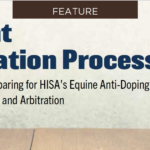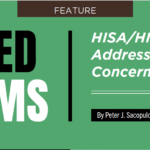Most legal professionals admit there is nothing new about medical malpractice claims. It’s the other ways healthcare providers are sued that poses some of the greatest risks. And those instances — which do not include medical malpractice — may not be covered by professional liability coverage.
In the words of Dr. Seuss: “I have heard there are troubles of more than one kind. Some come from ahead and some from behind.”
Do you discriminate in cyberspace?
Imagine living life as one of the 1.3 million blind people in the United States. How would you access information exchanged over the Internet?
The American for Disabilities Act (ADA) makes it is easier for Mindy Jacobsen, a 60-year-old New York resident, who has been blind since birth, to navigate around New York City. She can walk sidewalk to sidewalk, hop on a train and live a fully functional life with the exception of navigating through the Internet.
“You go to a hospital’s website and want to get the pre-op information there, but it isn’t available and if it is, it is in a format we can’t read,” Jacobsen says. “Then we have to ask people to read it to us and it becomes such a big deal.”
Jacobsen uses a screen reader for web pages. It can read almost anything, which eliminates some barriers for the blind, but graphics are problematic.
“When my screen reader encounters graphics, it can’t read them. So it just quiets down and doesn’t do anything,” Jacobsen explains.
Government websites are required by law to be accessible. Websites of private or public companies are not held to the same standard, but that doesn’t stop lawsuits.
The most famous and commonly cited case was litigated several years ago, when the National Federation of the Blind filed a suit against the retail giant Target. The plaintiffs in the case [National Federation of the Blind v. Target Corp., 452 F. Supp. 2d 946 (N.D. Cal. 2006)] alleged Target’s website was not ADA compliant. And they asserted that Title III of the ADA, which applies to places of public accommodation, also applies to e-commerce websites. The plaintiffs were blind individuals who claimed the Target website discriminated against them since the website did not work well with screen reading software. The case was the first lawsuit applying the ADA to a website that survived a motion to dismiss. It was settled out of court for a reported $6 million dollars.
Administrative risk
On May 4, 2011, the United States District Court in Kansas allowed a plaintiff to advance an administrative negligence claim against a hospital administrator. Sandra and Edwin Deya claimed that a medical director failed to create, develop and refine policies and protocols for newborn care at Hiawatha Community Hospital. The Deyas argued that the absence of appropriate policies and protocols contributed to permanent injuries suffered by their newborn child.
While the federal court in Kansas ruled that the claim was not a medical malpractice claim, it added that, pursuant to the Restatement of Torts § 324A, the administrator had undertaken a duty to establish and maintain written policies or procedures for the newborn unit at Hiawatha Community Hospital.
And the court acknowledged that the claim was unique. “The argument that no state or federal Kansas case has affirmatively recognized a duty on the part of the physician acting purely in an administrative capacity under Restatement (2nd) of Torts § 342A, does not establish that the proposed amendment here is futile.”
The federal court noted that three different courts outside of Kansas have considered an implied duty on the part of a physician could arise under this section of the Restatement of Torts. The Kansas ruling is important in a couple respects, including:
- It opens the door to general negligence claims against physicians serving as medical directors and administrators of hospitals and outpatient surgery centers.
- It may raise insurance coverage issues. Physicians who work as medical directors or administrators may wish to check their professional liability policies to see if they cover medical decisions outside the course and scope of the traditional physician-patient relationship. The Kansas court, by finding that claims of this nature are not medical malpractice but can progress under general negligence theory may create insurance coverage issues for physicians who act in administrative capacities.
Typical professional liability coverage is limited to acts that are the “practice of medicine.” Administrative activities may fall outside of typical professional liability policies. If so, a medical director should have a “Directors and Officers” policy to cover his/her actions as a medical director.
This relatively new theory of plaintiffs appears to allow an end run around medical malpractice statutes in certain circumstances. By advancing a claim based in administrative negligence and not medical negligence the plaintiff is able to avoid statutory obligations found in medical malpractice cases. For example: in many states plaintiffs are required to file an affidavit of merit to initiate a medical malpractice claim. Administrative negligence claims would not require the filing of such an affidavit.
Letters of recommendation
Recent legal cases — with hefty settlement amounts — may cause medical professionals to think twice about handing out letters of recommendation.
Notably, when a Louisiana doctor was fired for diverting Demerol from his patients; and showing up to work under the influence he asked another doctor to write him a letter of recommendation. And he did. The doctor took the glowing recommendation and got a new job thousands of miles away in Washington.
About a year into his new job, the doctor was deemed to be “under the influence” when he failed to properly administer anesthesia and let a patient fall into a permanent vegetative state. The patient’s family filed a malpractice lawsuit against the doctor and the medical center where he worked. The case was settled with the doctor paying $1 million and the medical center paying $7.5 million.
The court ruled that the doctor who wrote the letter of recommendation engaged in negligent misrepresentation and ordered him to pay the medical center $8.2 million in total damages, which represented the full settlement amount plus the center’s legal bills.
And it gets worse. Medical malpractice insurance did not cover him in the lawsuit. The insurance company argued that its coverage guarantee did not apply since the doctor had not personally committed bodily injury. In the end he paid $8.2 million in damages for someone else’s medical error because of a three-sentence evaluation he penned.
Battery?
Medical battery is defined as the intentional violation of a patient’s rights to direct his or her medical treatment. No injury or negligence is necessary for a finding of medical battery. Battery involves an unauthorized touching of another person and medical battery occurs when a patient is treated without informed consent. Most commonly, battery charges are alleged when there is a dispute over whether the patient agreed to or refused treatment.
In the case Zarko Sekerez v. Rush University Medical Center, the patient (Sekerez) suffered from a cerebral hemorrhage caused by his invasive cancer and multiple infections that led to:
- Septic shock
- Respiratory failure
- Drop in blood pressure
Rush University Medical Center is a teaching hospital that uses a supervising doctor, attending physician, to supervise the work of fellows, residents and interns. The attending physician supervised two doctors and two interns. When Sekerez’s providers tried to care for him, the patient’s family sued. Alleging that the physicians were negligent in administering drugs against patient’s stated wishes; Sekerez’s family brought a claim for medical battery based on failure to obtain consent. The decedent did not sign a general consent form for treatment upon his admission to Rush University Medical Center. However, during the time of his hospitalization, Rush University Medical Center had a general consent policy.
After review of the hospital records and autopsy report, the administering of the four doses of Lovenox was the proximate cause of the decedent’s death. One of the physicians who testified in court read into evidence an excerpt from Rush University Medical Center’s consent policy which explained the purpose of consent: “Hospital personnel have a legal duty to refrain from treating the patient unless the treatment has been authorized by the patient. Similarly, the patient has a right to refuse to authorize treatment. The physician admitted to the court that there was no written or verbal consent in decedent’s chart for the administering of Lovenox.
Predatory lending
Medical groups are finding new ways to offer credit options to patients, to cover the cost of services. As a result, medical group professionals should be aware of predatory lending, or activities that violate consumer laws. A common element to most of these cases includes a lender or lender’s agent engaging in fraud or deception to conceal the true nature of the loan obligation with unsuspecting or unsophisticated borrowers. This means that a practice could be sued based on what information was presented to a patient or for how a signature of the application was secured.
For example, in 2011 an East Coast dentist was sued for her use of CareCredit and Chase Health Advance at her practice. A patient claims she did not understand that she was signing a credit application and alleges that the practice performed unnecessary work to collect the entire amount of her line of credit.
Because this is not a medical malpractice case normal professional liability policies do not cover it. And given the general public’s hostility towards finance firms, there is a risk to taking the case to a jury.
Knowledge is Power
If you can identify potential liability risks, you can avoid them. With a little planning and the creation of a few simple procedures, you increase your odds of avoiding litigation. Here is what I suggest:
- Provide patients requesting financing options standard written information provided by the lending firms.
- Instruct your staff to direct questions to the lending firm; your staff should not interpret lending firm’s information.
- When signing an agreement with a patient lending firm, your practice should require that the lending firm indemnity the practice from any predatory lending claims. This means if the practice is sued, the lending firm will be responsible for the legal costs.
- Document when information is provided to a patient, be able to produce an exact copy of what was given to the patient
Michael J. Sacopulos is a partner with Sacopulos, Johnson & Sacopulos in Terre Haute, Indiana. He also serves as Legal Analyst for Dental Products Report, Plastic Surgery Practice and is National Counsel for Medical Justice Services, Inc. His practice focuses on assisting healthcare professionals develop strategies and techniques to avoid medical liability claims. Mr. Sacopulos returned to Indiana to practice law after attending Harvard College and the London School of Economics. He may be reached at Mike_Sacopulos@Sacopulos.com.




